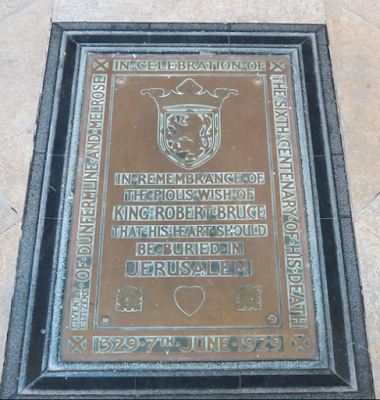The Braveheart That Was Almost Buried in Jerusalem

בסרט המצליח "לב אמיץ" מגלם מל גיבסון את דמותו של הגיבור הלאומי הסקוטי בן המאה ה- 13 ויליאם וולאס, שהוביל את הסקוטים במלחמת העצמאות הראשונה שלהם כנגד המלך האנגלי אדוארד הראשון "ארך הגפיים" (שכונה גם "פטיש הסקוטים"…). דמות מרכזית נוספת בסרט היא זו של רוברט דה-ברוס, אציל סקוטי שזכה לתמיכתו של וולאס והפך בהמשך למלך סקוטלנד רוברט הראשון. רוברט אף ניצח את האנגלים בהנהגתו של המלך אדוארד השני, בנו של אדוארד "ארך גפיים", בקרב באנוקברן ההיסטורי בשנת 1314.
רוברט נפטר בשנת 1329, ככל הנראה ממחלת הצרעת, וביקש בצוואתו כי ליבו ייקבר בירושלים. הלב נמסר לאביר ג'יימס דאגלס "השחור" אשר לקח אותו עימו כשיצא לארץ הקודש. לרוע מזלו של המלך הסקוטי, האביר נהרג בקרב עם מוסלמים בספרד במהלך מסעו ולא הצליח להשלים את משימתו. הלב המלכותי הוחזר לסקוטלנד ועקבותיו נעלמו. בשנת 1921 התגלה במנזר מלרוז מיכל עליו כתוב כי הוא מכיל את ליבו של המלך הסקוטי, והוא טמון שם עד היום. בראשית המאה ה- 19 התגלה גם קברו של רוברט במנזר דנפרמליין, והתברר כי עצם החזה של השלד נוסרה לאורכה – מה שמצביע על כך שליבו של המלך אכן הוסר מגופו לאחר מותו.
כנסיית סנט אנדרו, הידועה גם בשם הכנסייה הסקוטית, שוכנת על גבעה מול הר ציון על יד תחנת הרכבת ההיסטורית של ירושלים והחאן הירושלמי. היא נבנתה בין השנים 1927-1930 בתקופת המנדט הבריטי כדי להנציח את זכרם של החיילים הסקוטים ששירתו בצבא הבריטי ונהרגו במלחמת העולם הראשונה, וקרויה על שמו של פטרונה של סקוטלנד אנדרו הקדוש. את אבן הפינה של הכנסייה הניח הגנרל אלנבי, כובש ירושלים וארץ ישראל מידי העות'מאנים.
The church was designed by the British architect Clifford Holliday, who was one of the most important planners of modern Jerusalem during the Mandate period, and it combines Western and Eastern motifs. In the church building, a special stone was used that absorbs lichens, so that it will look old quickly and give the church an ancient appearance.
Although the church is relatively new, it preserves the ancient tradition related to the heart of King Robert too. The heart itself is buried as mentioned in Scotland, but the church in Jerusalem has a memorial plaque that indicates its story. Since the church commemorates the slain British soldiers, two British sniffer dogs who took part in the fighting are also buried in its courtyard. One of these dogs was named Bruce, after the Scottish king whose heart remains in his faraway homeland.

(Anecdote authored by: עמיר)
(Number of views: 83)
